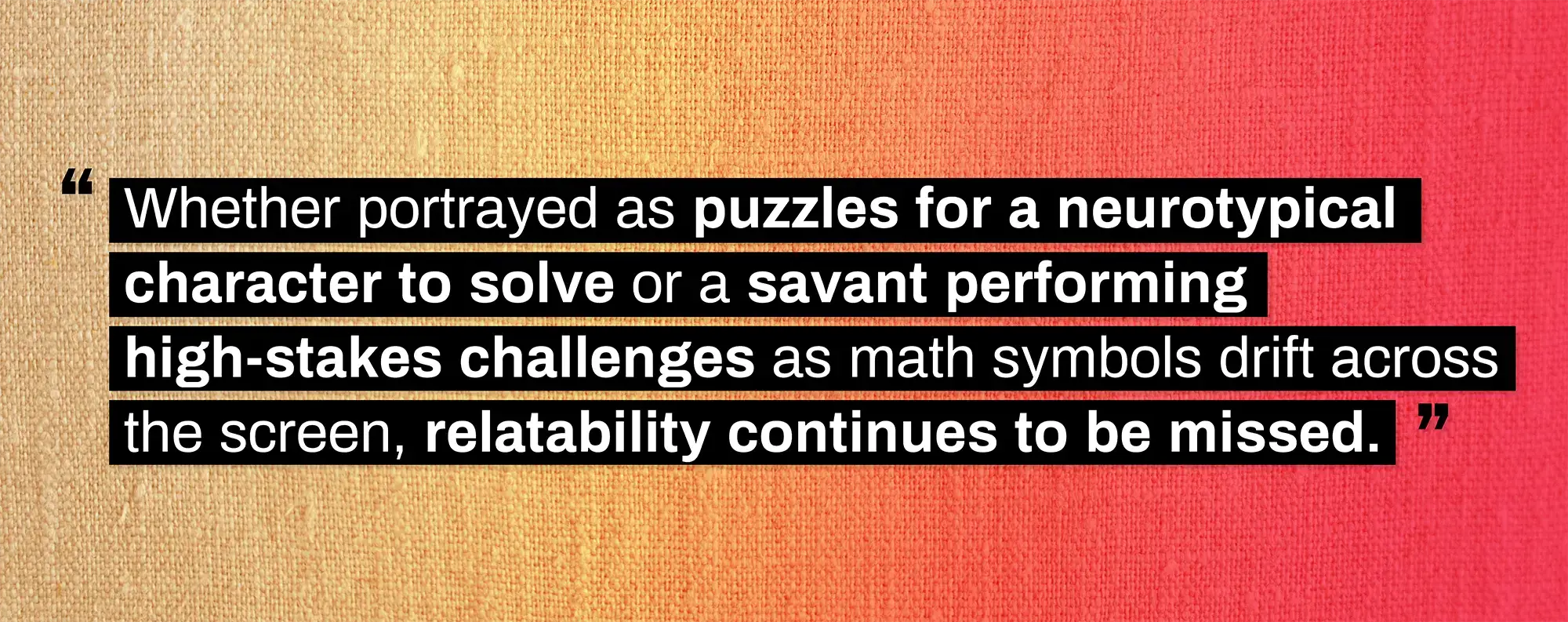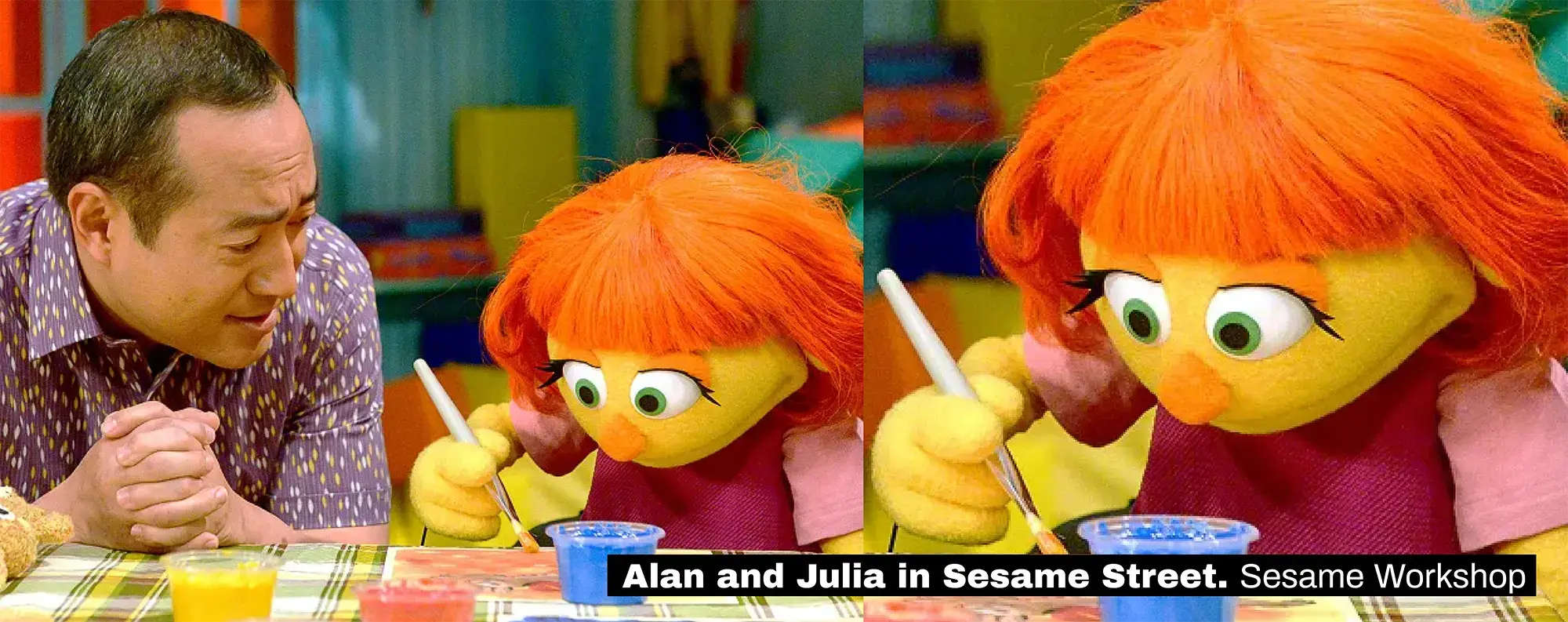The world knew who Raymond Babbitt was and what “autistic savant” meant after the release of Barry Levinson’s film Rain Man (1988). Given the film’s success, it is easy to appreciate what Rain Man has done to recognize Autistic Spectrum Disorder (ASD). However, much has developed in the representation of neurodivergence in the media since then. Efforts to stop considering autism as an illness reached a milestone in 1998 when sociologist Judy Singer coined the term “neurodiversity,” which describes the different ways in which the brain functions.
Before today’s understanding of ASD, it can be hard to imagine how influential Rain Man was for the representation of people with disabilities. Any seemingly “positive” impact, however benign, can become clichéd when the stories of people with disabilities never change. One could say that just the awareness of neurodivergence was the film’s most significant takeaway for its time. As a more evolved audience, what we demand most from the media we consume is relatability.
We all know the immense power the media has on our cultural consciousness. Much like our conception of ASD coming from Rain Man’s leading character Raymond Babbitt, films such as One Flew Over the Cuckoo’s Nest and Girl Interrupted illustrate our collective imagination of a psychiatric ward.
This narrow representation can be patronizing for patients in rehabilitation, potentially inducing trauma and misrepresentation of communities. Instead of regarding films as a singular, individualized experience, audiences believed these films represented the actual places they depicted. In the thirty-four years since Rain Man, the representation of neurodivergent people has gone through a trial-and-error gauntlet in creating relatable characters with staying power.
Before Rain Man—and much before Hollywood portrayed a wider range of everyday people—similar characters with varying psychiatric disorders were shown in unrelatable scenarios. The heroic story of Helen Keller in The Miracle Worker (1962) left audiences touched and inspired by Keller’s perseverance and eventual success as an author and disability rights advocate. However, the film’s tone of American exceptionalism left members of the blind and D/deaf community—who didn’t have access to a miracle worker like Anne Sullivan—ironically unseen and unheard.
In Sybil (1976), a girl’s traumatic experience leads to her developing dissociative identity disorder. Audiences, entertained by the film, warmly wrapped themselves with the relief that “this would never happen to me.” Sybil, adapted from Flora Rheta Schreiber’s book of the same name, recounted the story of Shirley Ardell Mason. Psychiatrist Herbert Spiegel challenged the book and film’s integrity, as well as the ethics of the psychiatrist who treated Mason, Dr. Cordelia Wilbur.
Rather than publishing her findings in a peer-reviewed scientific journal—a standard practice—Wilbur went directly to Schreiber to craft an alluring tale of a troubled girl. It was eventually revealed her diagnosis was exaggerated for financial gain. Even after this significant reveal to the public, general audiences continued to consume Sybil not for relatability—or at the very least, awareness–but as a “problem play,” a type of drama that deals with controversial social issues to stimulate thought and discussion. The film continued to garner similar interest to that of a scandalous tabloid.
Following Rain Man, mental illness was often blamed on unwell parents and poverty, following the now-discredited “Refrigerator Mother Theory.” In What’s Eating Gilbert Grape (1993), the main character, Arnie shows the physical characteristics and emotional isolation of ASD and is the reason behind the family’s emotional turmoil and stress. The film gained critical success, nearly equal to Rain Man, but only further perpetuated the negative experiences of ASD.
The later developments of neurodivergent characters did not stray far from the Raymond Babbitt template. In the mid-2000s, one significant development was the social inclusion of neurodivergent characters. But once again, they were featured in unrelatable, very privileged, scenarios. The most popular example of this is the (often white) mid-to-late-thirties “autistic savant,” who excels in a distinguished field. Sheldon Cooper from The Big Bang Theory is a popular representation of this phenomenon, playing the character of a Theoretical Physicist at Caltech with an I.Q. of 187. The idea that ASD is a form of genius leads audiences to assume that all people with ASD have savant skills. In reality, the prevalence of savantism occurs in fewer than one in ten individuals with ASD.
Surprisingly, the “problem play” became most prevalent in Music (2021), directed by Sia. It was most criticized for including a graphic scene of restraint, “[a] physical force used to immobilize—or reduce the ability of—an individual,” which is considered abuse within the autism community and has since been replaced by deep-pressure stimulation. Also, Maddie Ziegler, a neurotypical dancer (famous for Sia’s music videos) was cast for the lead role of a nonverbal person, who executed facial expressions more outdated than what was seen in films decades prior. Other critical responses to Music included social media backlash from the autism community noting how triggering the actress’s interpretation of tics and stimming were. Youtuber Paige Layle said in her video response, “You can’t act autistic without making it look like a mockery.”

Whether portrayed as puzzles for a neurotypical character to solve, or a savant performing high-stakes challenges as math symbols drift across the screen, our demand for relatability continues to be missed. Good intentions followed by gross misunderstandings are bound to happen before nuances can be revealed. But once these nuances are established, creativity can really take its course. Alas, creating a relatable character is no easy feat. GLAAD, a media advocacy organization for the LGBTQ+ community, found only 27 characters (3.1%) in the overall current shows on the air are people with disabilities. It is not a matter of how many characters exist, but how they are written, that creates relatability. A large spectrum lies between Arnie Grape and Raymond Babbitt, where more nuanced characters are just waiting to be created.
Characters in the media coded with neurodivergence, not showing an explicit disability in their storyline, are often observed retrospectively. In the Netflix series Orange Is the New Black (2013-2019), Suzanne Warren, played by Uzo Aduba, is never explicitly diagnosed. However, she shows signs of neurodivergence and queerness in her quirky readings of social cues and innocent crushes on fellow inmates. Her story arc also addresses the horrific treatment of mental illness within the prison system. In an early episode, Suzanne, referred to by other inmates as Crazy Eyes, tells the new inmate Piper, “Once you go to psych, you get lost in psych.” Aduba has openly spoken about the treatment of inmates with mental health issues in the prison system. In an interview on the offCamera Show with Sam Jones, Aduba said, “We really need to start asking ourselves what are we doing to really help and save these people and resuscitate their lives.”

Neurodiversity is gaining awareness in mainstream children’s entertainment. In 2015, Sesame Street introduced a character named Julia, created to represent children with autism and foster greater empathy and understanding, as part of the Sesame Street and Autism: See Amazing in All Children initiative. The puppeteer behind Julia, Stacy Gordon, has a neurodiverse son and plans to take her show on the road. Even Pixar has created two films, Loop and Float, featuring neurodivergent characters who are also multicultural. This direction finally speaks to the overlooked intersectionality of racism and ableism.

High-profile people who’ve spoken publicly about their neurodiversity have also made a positive impact. Greta Thunberg has credited her sense of purpose in climate activism to her different way of seeing things. Hannah Gadsby has spoken openly in her standup routine about her autism and has said, “Difference is a teacher. Fear difference, learn nothing.” Actress Kayla Cromer, star of Everything’s Gonna Be Okay, recently became the first neurodivergent actress cast as a lead character with autism on TV—a significant step toward widespread authentic representation.
When it comes to media authenticity, Hollywood needs to nip the casting of neurotypical actors in the bud. A new Amazon Prime series, As We See It, bucks that trend. The series stars three neurodiverse people living together as roommates. Reality television is also showing the humanized experience of dating in the Netflix series Love on the Spectrum. For working actors with disabilities, particularly women of color, exists the organization Divas with Disabilities (DWD). DWD is a digital movement committed to increasing the participation and representation in the media of Black and Brown women with disabilities.
While past characters show what autism is, we can now begin understanding how autism works. We can move on from Raymond Babbitt, Arnie Grape, and even Sheldon Cooper. We need more of the neurodiverse teenager fascinated by flags, the adult managing her executive functions at work, or the non-verbal person who glues a family together, not burdens it. Having neurodiverse characters in mainstream media fosters awareness and empathy and is the true catalyst for acceptance, inclusion, but most of all: justice.





